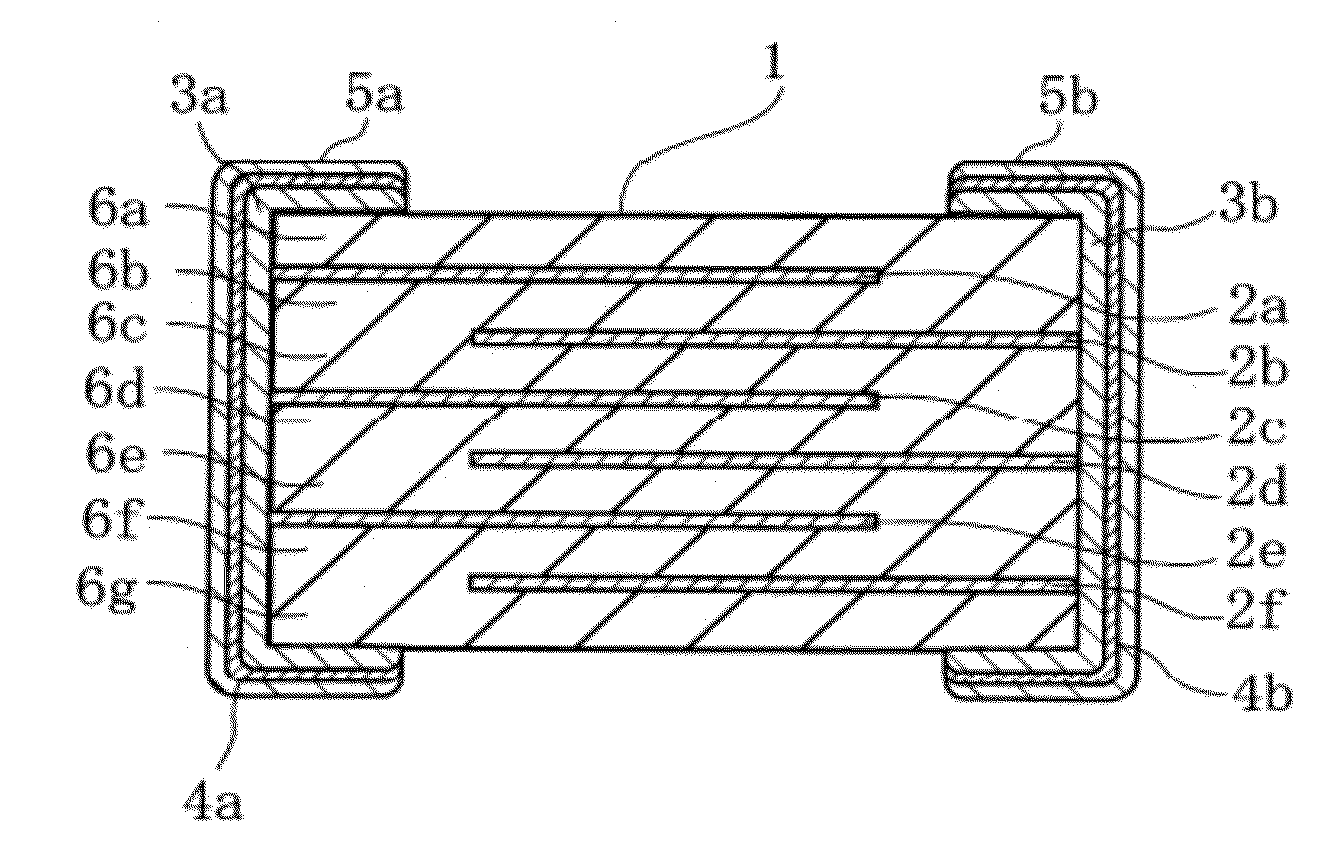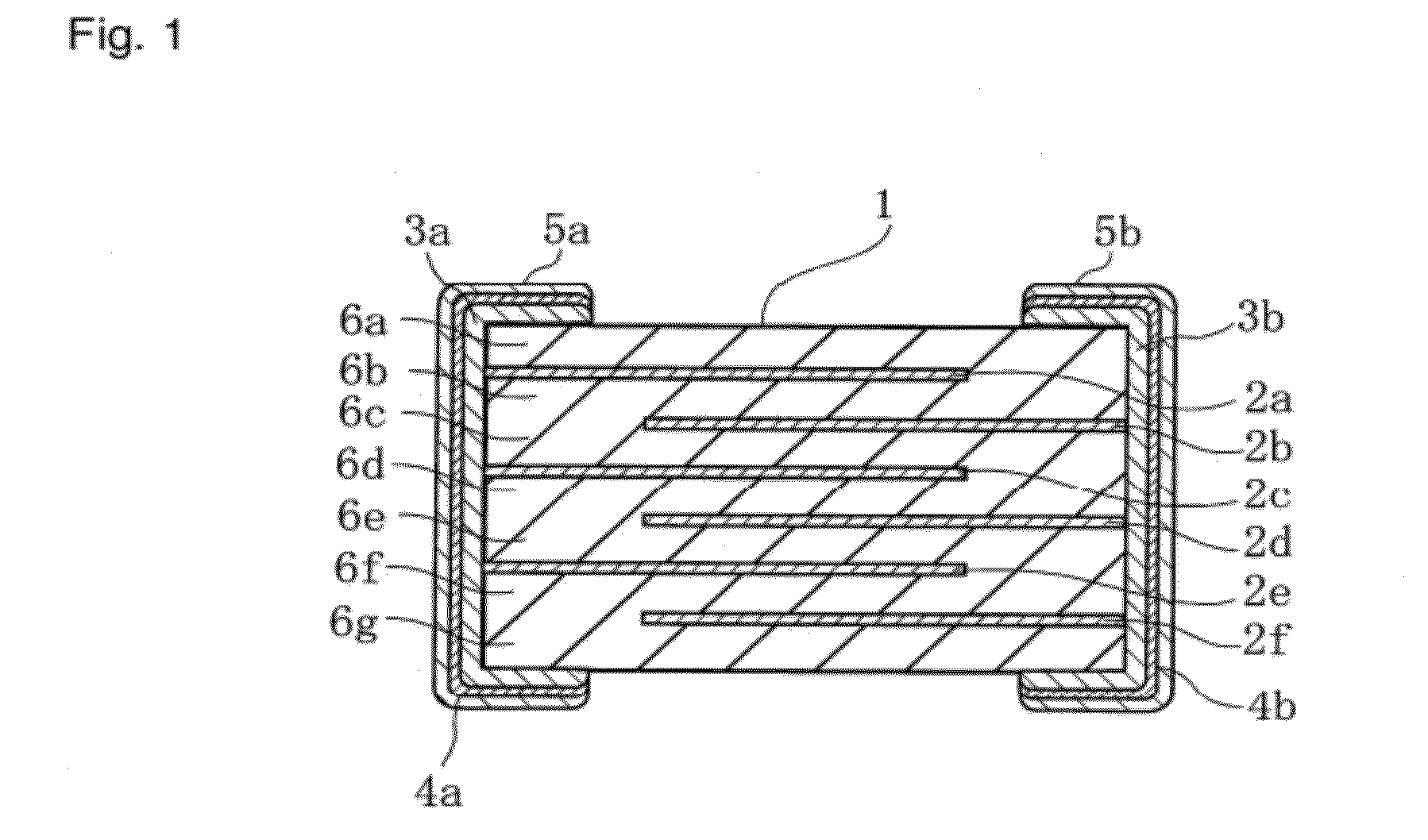Dielectric ceramic and laminated ceramic capacitor
a technology of laminated ceramic capacitors and dielectric ceramics, applied in the direction of ceramics, fixed capacitors, electrical equipment, etc., can solve problems such as inability to meet the requirements of high temperature loading, and achieve the effects of improving reliability, improving characteristics, and high temperature loading
- Summary
- Abstract
- Description
- Claims
- Application Information
AI Technical Summary
Benefits of technology
Problems solved by technology
Method used
Image
Examples
example 1
Preparation of Samples
[0069]BaCO3 and TiO2 were weighed in predetermined amounts as ceramic raw materials, and these weighed materials were put along with PSZ balls and pure water into a ball mill, subjected to mixing and grinding in a wet way, and to drying, and then subjected to a heat treatment at a temperature of 1150° C. for about 2 hours, thereby preparing a main constituent powder composed of Ba1.003TiO3 with an average grain size of 0.15 μm.
[0070]Next, Al2O3, MgCO3, and SiO2 were prepared. These oxides were weighed so as to provide Al2O3:MgCO3:SiO2=1:2:2 in terms of molar ratio, and these weighed materials were put along with PSZ balls and pure water into a ball mill, subjected to mixing and grinding in a wet way, and then subjected to a heat treatment at 900° C. to prepare an Al—Mg—Si oxide. It is to be noted that this Al—Mg—Si oxide had an average grain size of 0.08 μm.
[0071]Then, the main constituent powder described above and the Al—Mg—Si oxide were weighe...
example 2
[0096]BaCO3, CaCO3, SrCO3, TiO2, ZrO2, and HfO2 were prepared as ceramic raw materials. Then, these ceramic raw materials were weighed so as to provide the compositions of main constituents as shown in Table 2, put along with PSZ balls and pure water into a ball mill, subjected to mixing and grinding in a wet way, and to drying, and then subjected to a heat treatment at a temperature of 1100° C. to 1200° C. for about 2 hours, thereby preparing a main constituent powder with an average grain size of 0.11 μm to 0.17 μm.
[0097]Next, Al2O3, MgCO3, and SiO2 were prepared and these oxides were weighed so as to provide Al2O3:MgCO3:SiO2=1:4:4 in terms of molar ratio. These weighed materials were put along with PSZ balls and pure water into a ball mill, subjected to mixing and grinding in a wet way, and then subjected to a heat treatment at 900° C. to provide an Al—Mg—Si oxide. It is to be noted that this Al—Mg—Si oxide had an average grain size of 0.06 μm.
[0098]Then, the main constituent pow...
example 3
[0104]BaCC3, CaCO3, TiO2, and ZrO2 were prepared as ceramic raw materials. These ceramic raw materials were weighed in predetermined amounts, put along with PSZ balls and pure water into a ball mill, subjected to mixing and grinding in a wet way, and to drying, and then subjected to a heat treatment at a temperature of 1150° C. for about 2 hours, thereby preparing a main constituent powder composed of (Ba0.93Ca0.07)0.998(Ti0.996Zr0.004)O3 with an average grain size of 0.17 μm.
[0105]Next, Al2O3, MgCO3, and SiO2 were prepared. The oxides were weighed so as to provide Al2O3:MgCO3:SiO2=1:2:4 in terms of molar ratio, and these weighed materials were put along with PSZ balls and pure water into a ball mill, subjected to mixing and grinding in a wet way, and then subjected to a heat treatment at 1000° C. to provide an Al—Mg—Si oxide. It is to be noted that this Al—Mg—Si oxide had an average grain size of 0.07 μm.
[0106]Next, M1CO3 (M1 is Ba and Ca), RO3 / 2 (R is La, Ce, Pr, Nd, Sm, Eu, Gd, T...
PUM
| Property | Measurement | Unit |
|---|---|---|
| dielectric constant | aaaaa | aaaaa |
| molar ratio | aaaaa | aaaaa |
| thickness | aaaaa | aaaaa |
Abstract
Description
Claims
Application Information
 Login to View More
Login to View More - R&D
- Intellectual Property
- Life Sciences
- Materials
- Tech Scout
- Unparalleled Data Quality
- Higher Quality Content
- 60% Fewer Hallucinations
Browse by: Latest US Patents, China's latest patents, Technical Efficacy Thesaurus, Application Domain, Technology Topic, Popular Technical Reports.
© 2025 PatSnap. All rights reserved.Legal|Privacy policy|Modern Slavery Act Transparency Statement|Sitemap|About US| Contact US: help@patsnap.com



